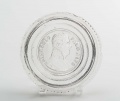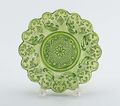Difference between revisions of "Pressed glass"
Jump to navigation
Jump to search
(username removed) |
|||
| (10 intermediate revisions by 3 users not shown) | |||
| Line 1: | Line 1: | ||
| − | [[File:1994.34-SC42485.jpg|thumb| | + | [[File:1994.34-SC42485.jpg|thumb|Glass compote<br>MFA Acc. # 1994.34]] |
== Description == | == Description == | ||
| − | An inexpensive glassware prepared by pressing molten glass into a mold with a plunger. Pressed glass became popular in the 19th century after the development of a glass-pressing machine in 1825 by John P. Bakewell led to mass production. Until the mid 1860s, most pressed glass was made from high-quality [ | + | An inexpensive glassware prepared by pressing molten glass into a mold with a plunger. Pressed glass became popular in the 19th century after the development of a glass-pressing machine in 1825 by John P. Bakewell led to mass production. Until the mid 1860s, most pressed glass was made from high-quality [[flint%20glass|flint glass]]; after that point, less expensive [[soda%20glass|soda glass]] was used. |
== Synonyms and Related Terms == | == Synonyms and Related Terms == | ||
| Line 11: | Line 11: | ||
<gallery> | <gallery> | ||
| − | File:66.1090-SC41993.jpg| | + | File:Salt dish-SC42566.jpg|Salt dish <br>MFA# 65.609 |
| + | File:66.1090-SC41993.jpg|Cup Plate <br>MFA# 66.1090 | ||
| + | File:Oil lamp-SC41837.jpg|Whale oil lamp<br>MFA# 1978.747 | ||
| + | File:Yellow glass-SC41918 (1).jpg|Canary yellow candlestick<br>MFA# 1982.641 | ||
| + | File:Glass decanter-SC42261.jpg|Glass decanter<br>MFA# 1978.1252 | ||
| + | File:Pressed glass-SC41903.jpg|Sauce dish<br>MFA# 1979.713 | ||
</gallery> | </gallery> | ||
| + | == Resources and Citations == | ||
| − | + | * ''Encyclopedia Britannica'', http://www.britannica.com Comment: Pressed Glass. Accessed April 29, 2004. | |
| − | * '' | + | * Edward Reich, Carlton J. Siegler, ''Consumer Goods: How to Know and Use Them'', American Book Company, New York City, 1937 |
| − | * | + | * Susan E. Schur, Conservation Terminology: A review of Past & Current Nomenclature of Materials, ''Technology and Conservation'', Spring (p.34-39); Summer (p.35-38); Fall (p.25-36), 1985 |
| − | |||
| − | |||
[[Category:Materials database]] | [[Category:Materials database]] | ||
Latest revision as of 14:28, 25 August 2020
Description
An inexpensive glassware prepared by pressing molten glass into a mold with a plunger. Pressed glass became popular in the 19th century after the development of a glass-pressing machine in 1825 by John P. Bakewell led to mass production. Until the mid 1860s, most pressed glass was made from high-quality Flint glass; after that point, less expensive Soda glass was used.
Synonyms and Related Terms
geperst glas (Ned.); vidro prensado (Port.)
Additional Images
Resources and Citations
- Encyclopedia Britannica, http://www.britannica.com Comment: Pressed Glass. Accessed April 29, 2004.
- Edward Reich, Carlton J. Siegler, Consumer Goods: How to Know and Use Them, American Book Company, New York City, 1937
- Susan E. Schur, Conservation Terminology: A review of Past & Current Nomenclature of Materials, Technology and Conservation, Spring (p.34-39); Summer (p.35-38); Fall (p.25-36), 1985






